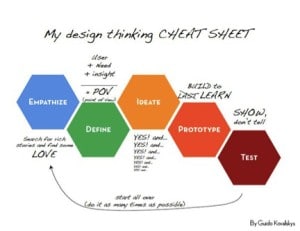DESIGN THINKING IN HEALTHCARE
By Emma Fogt MBA, MS, RDA,LDN, FAND
Defining Design Thinking
Design thinking is a step-by-step creative process used to elicit innovation or new ideas and concepts. The first step is defining the problem and then taking time to observe it from different angles without judgment. The next step is to consider the many options that could solve the problem. From these options the one which makes the most sense is selected. It may require a few attempts back to square one to refine the process. In the end, the winner is chosen and the idea is executed.
What makes design thinking so user friendly is that it devises a solution around the end user and makes the solution around them (1).
How Design Thinking is Used
I have used design thinking unknowingly on many projects. Since my top strengths include ideation, individualization and strategy- and I am a closet artist, I enjoy big picture thinking.
I used design thinking for a networking event in Philadelphia for Nutrition Entrepreneurs. The Executive Board I was working with collected together to find the most innovative steps we could take to serve our members for the networking event while making it fun. Through design thinking all ideas were put on the table and without fear we ended up with a creative event theme, logo and tag line which was utilized throughout all our event materials and projects.
What is exceptional about design thinking which I love is that there is no failure involved. The wildest ideas are often the ones which get selected in the end and maximum input is encouraged.
Design thinking can be used for so many processes such as products, services and business strategy. We are starting to use it also in healthcare to be able to reach our end user- the patient.
Health and Wellness Uses Design Thinking
In healthcare- design thinking is often people focused as it takes into account the needs of the patient. Instead of making a product just meet the needs of the user (say the dentist) the product can be designed with the patient in mind. (for example a quieter, softer dental tool).
To best understand the end user (the patient), The Mayo Clinic advises we need empathy- in other words we need to know how patients feel when using a device or product (2).
How can healthcare providers like nutritionist’s help motivate patients and have them become part of their own health solution?
Just throwing out a diet plan and exercise instructions to patients does not work – as the healthcare providers we need to pay close attention and observe emotions, body language and conversations. In this manner design thinking can play a big role. We need to find out why patients are having difficulty following through and it may have nothing to do with what we have been trained to advise (2).
The solution may be as simple as asking the user- why does this work and why does that not? How can I help you best and how can I deliver what you need? To do this we need to step outside of our constraints within a frame so we can get into their space and their viewpoint to overcome barriers in that way.
Design Thinking Focuses on Creativity, Empathy, and Rationality
Yes- you do not have to be a designer to incorporate design thinking into your work. We need to take into account the patient experience. Not just what we have been taught to execute. Protein needs, calories, the triad of weight control.
To get into the white space we need to develop high quality products by deliver value and experiences that delight people. We need to change our focus to health- goals for value- deliver better health outcomes rather than more healthcare. Tele-coaching, apps and technology can help us to provide better outcomes. Lifestyle and behavior change can go beyond clinics and into patient homes. Design thinking involves making complicated medical jargon more user friendly.
Design thinking can be applied to any fields- whether it is politics, law or medicine- not just design itself. We need to decide where different people are coming from patients and clinicians to come into a shared understanding to healing.
Great design looks and feels effortless, the final product is so user friendly it does not require a lot of learning how to use it. To create healthcare by great design- it needs to be intuitive and natural. Design Thinking is a tool which health care providers can use to meet their patients where they are at.
REFERENCE:
- Soule, S., (10/30/13) Why Design Thinking Is an Effective Tool for Social Entrepreneurs extracted from the website: http://www.gsb.stanford.edu/news/headlines/sarah-soule-why-design-thinking-effective-tool-social-entrepreneur May 11, 2014
- Montpetit, A., (05/13/14) Key Elements of design Thinking. Extracted from the website: http://blog.centerforinnovation.mayo.edu/discussion/5-key-elements-of-design-thinking. May 21,2014.

